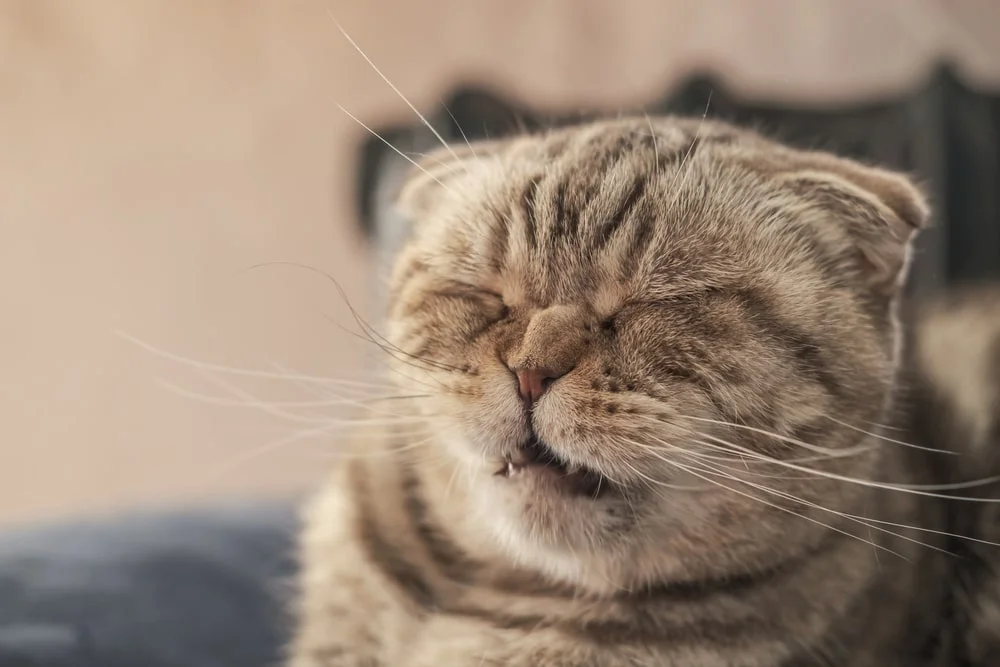PET HEALTH
Few things are as adorable as a cat sneezing. But just like for humans, sneezing can be an indicator of something more serious than an itchy nose. Feline calicivirus (FCV) is a highly infectious disease that can cause frequent sneezing. But what exactly is calicivirus, and how can it be treated? Keep reading to find out.
What Is Feline Calicivirus?
Calicivirus is one of the most common cat diseases responsible for oral and upper respiratory infections. After being exposed to the virus, cats may go through an incubation period of 2 to 6 days before displaying symptoms.1 The infection can last anywhere from 2 to 3 weeks, during which the infected cat will shed the virus.1
It can most easily spread to other cats via sneezes. Calicivirus might also be present in the infected cat’s urine or feces, but this usually isn’t how it spreads. Still, it’s very easy for calicivirus to spread among cats in shelters, vet clinics, and other gathering places. It can even be spread by humans who pet a sick cat.
Symptoms of Calicivirus in Cats?
Sneezing is just one of the possible symptoms of feline calicivirus. Other signs to look out for can include:1
- Ulcers on the tongue and mouth
- Excessive drooling
- Nasal congestion
- Conjunctivitis
- Discharge from the eyes or nose
- Lethargy
- Decreased appetite
- Weight loss
- Fever
- Swollen lymph nodes
- Sudden lameness in joints (usually among kittens)
A more severe strain of feline calicivirus can cause jaundice (yellowing of the skin and eyes), high fevers, swelling of the legs and face, and multiple organ diseases. About 67% of all cats who contract this variant of calicivirus die, so bring your cat to a vet if any of these symptoms arise.1
When in Doubt, Get your Cat Checked Out
How Is Feline Calicivirus Diagnosed?
If your cat is presenting multiple symptoms of calicivirus, it’s likely your vet will presume a positive diagnosis and begin treatment. Obtaining a more definitive diagnosis requires more intensive testing. This may involve sampling your cat’s discharge for polymerase chain reaction tests, viral isolation, or immune-histochemical staining. Sometimes, the virus can spread to a cat’s lungs, in which case your vet may recommend a transtracheal wash to obtain additional samples. Your vet might also run potentially costly X-ray and blood tests to rule out other possible causes of your cat’s symptoms.
Treating Calicivirus in Cats
Once diagnosed, feline calicivirus can be relatively simple to treat. Typically, your vet will recommend prescriptions to manage calicivirus symptoms, including:
- Anti-inflammatory medication to relieve joint pain and lameness
- Antibiotics to manage additional infections
- Topical eye ointment to manage discharge
More extreme cases may require hospitalization to keep your cat fed and hydrated during treatment. Otherwise, your vet will likely send you home with medication. Other at-home steps you can take include keeping a humidifier near your cat’s bed to help clear up their congestion. It’s also a good idea to regularly clean the discharge from their nose and eyes.
The Cost of Treating Calicivirus in Cats
Mild cases of feline calicivirus can cost $200 or less to treat.2 However, the more severe the infection, the more treatment your cat will require. If your cat ends up needing hospitalization, the bill could exceed several thousand dollars.2
Preventing Feline Calicivirus (FCV)
Most cats receive an FVRCP 3-in-1 vaccine as part of their core vaccines, with several boosters for the remainder of their lives. However, the vaccine only lessens the severity of the symptoms. It doesn’t prevent your cat from becoming infected.
The best way to prevent feline calicivirus is to be aware of who your cat is spending time with. The most common source of infection is other cats. If you’re going away on a trip and need someone to look after your cat, you might want to consider a sitter rather than putting them in a pet boarding facility. Similarly, if you have multiple cats, you may want to isolate the one with calicivirus, so it doesn’t spread to the rest of your furry family.
How Pet Insurance Can Help Cover the Costs of Feline Calicivirus (FCV)
The costs associated with calicivirus can be a burden to many pet parents. In fact, over 50% of owners aren’t able to afford medical treatment when their pets need it most. But with a cat insurance policy, you could be reimbursed for the cost of caring for your cat if they get diagnosed with FCV. Get a free quote from MetLife Pet Insurance to find out how much you could save while giving your cat the care they deserve.

